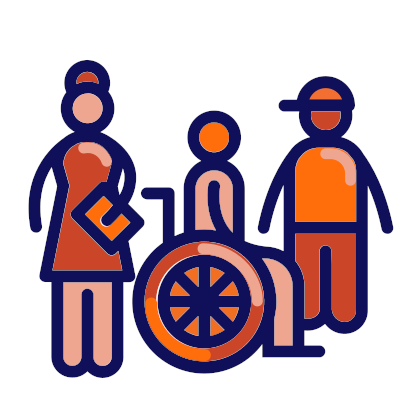Preventing bullying and violence

Schools can, and should, play a key role in tackling these abuses.
Whole-school anti-bullying programmes are needed, which promote peer support systems and involve active and well-trained teachers and parents, to foster a safe learning environment in which no violence is allowed.
Facts & figures
Half of the world’s students aged 13-15 say they have experienced violence in and around school.[1]
Nearly one in three students of this age say they have experienced bullying or been involved in fights.[2]
More than 700 million children have no legal protection from corporal punishment at school.[3]
What is violence and bullying?
Violence is the threatened or actual use of physical force or power resulting in physical or psychological harm to others.
Bullying is a form of violence. It can be defined as unwanted, aggressive behaviour which involves a real or perceived imbalance of power. It is behaviour that is repeated, or carries the threat of being repeated over time.
Bullying takes different forms in school, including:
- Physical, e.g., hitting, kicking, slapping, shoving, hair-pulling, etc.
- Verbal, e.g., name-calling, teasing, using belittling expressions, etc.
- Relational, e.g., ostracising, spreading rumours, social manipulation, etc.
- Sexual, e.g., sexual name-calling, uninvited touching, propositioning, etc.
Cyberbullying is a distinctive form of bullying. It differs from other types on account of the constant risk of public exposure, the complex roles of observers and the size of the audience that comes with digital technologies.[4].
Bullying is not the only form of student-on-student violence in schools, however. Fights between, and attacks on students associated with gang culture and the carrying of weapons, especially knives, are becoming an increasing problem in various countries.
Why is addressing violence and bullying important at school?
Under the U.N. Convention on the Rights of the Child, schools have a formal duty to protect children from all forms of violence, both physical and psychological.
“Parties shall take all appropriate legislative, administrative, social and educational measures to protect the child from all forms of physical or mental violence, injury or abuse, neglect or negligent treatment, maltreatment or exploitation, including sexual abuse, while in the care of parent(s), legal guardian(s) or any other person who has the care of the child.”[5]
Failure to protect children at school can have harmful repercussions on their future lives, both educationally and socially - whether they be victims, perpetrators or bystanders.
Students who are bullied are more likely to suffer from depression and anxiety, health issues, poor academic achievement and behaviour problems at school, including higher drop-out rates. A small number may also retaliate in violent ways. Students who bully others are more likely to exhibit other behaviour problems at school and to suffer from alcohol or drug abuse, and to engage in criminal activity and abusive relationships in adulthood. Children who witness bullying and violence are also more likely to have mental health difficulties and miss or drop out from school.
Violence and bullying not only affects academic learning, it also impacts negatively on the social development of young people. In particular, students who experience violence and bullying are more likely to have difficulty developing basic democratic competences, such as empathy, respect for others, openness to other cultures and beliefs, tolerance of ambiguity and self-efficacy – all of which lie at the heart of the Council of Europe Reference Framework of Competences for Democratic Culture.
The effects of violence and bullying are not limited only to the students directly involved, but potentially impact on everyone at a school. Unchecked, incidents of violence and bullying lead to an atmosphere of anxiety and insecurity incompatible with learning. They also lead to, or exacerbate conflicts beyond the school gates, which in turn have further consequences for relations within the school.
What are the challenges?
Violence and bullying can be challenging to deal with at school. What is regarded as bullying or violence is sometimes thought of as a matter of subjective opinion. It can be difficult to build a common approach to eradicating from school something which a significant proportion of staff believes not to exist or is not important to them.
The prevailing culture in a school can sometimes work against attempts to reduce violence in its different forms. Rule by fear, over-emphasis on punishment and the prioritization of learning environments which support competitive behaviour all militate against the prevention of violence and bullying. So, too, does the holding of an ideology which accepts violence as a valid response in situations of fear, stress or frustration – as evidenced in the advice commonly given to victims of bullying to fight back and give the bully a ‘taste of their own medicine.’
In such circumstances it can be easy to think that dealing with violence and bullying is simply a matter of stopping fights, giving punishments and imposing order, rather than questioning the wider culture of the school, the examples it sets and the sorts of behaviour it supports.
Many teachers are unaware of democratic approaches of dealing with violence and bullying, such as:
- restorative justice
- conflict resolution
- peer mediation.
Such approaches are not only arguably more effective than punitive ones, but also have the advantage of promoting democratic values and attitudes more widely across a school.
Such approaches take time to learn, however, and require the development of specific types of skills, knowledge and attitudes. They also take time to put into practice. It can be difficult for a teacher to find the time and motivation to deal with violence and bullying in a democratic and constructive way. It is easier just to punish the supposed perpetrator, and easier still to pass the perpetrator up the school hierarchy for a more senior member of staff to punish.
A further challenge in recent years has been the rise of gang culture among young people and the carrying of weapons, especially knives, in as well as out of school. This has led to a rise in the number of serious acts of violence between students and also to the more regular involvement of the police in school affairs, both of which demand new professional skills and ways of working from teachers and school leaders.
How can schools get active?
Taking action on violence and bullying is not just a matter of finding better ways of responding to incidents after they have occurred – though this is important, but also of creating the kind of school environment in which violent incidents are less likely to happen in the first place.
A good place to start is with asking students to review the current situation in their school:
- where they feel vulnerable or in danger
- where they feel safe
- what sorts of violence they have witnessed or experienced
- what they see as the causes of these sorts of violence
- how effective they think the school is at dealing with violence
- what further measures they would like the school to take.
Surveying student opinion provides a good evidence base for targeting measures to prevent violence, e.g., increasing supervision in areas in school where students are fearful of going, creating more opportunities for constructive play during breaks from lessons, etc.
It can also stimulate a whole-school conversation about violence and bullying. Such a conversation is important for arriving at a whole-school policy that everyone can support. It is an opportunity to develop a common language and understanding of what constitutes violence and bullying in school and shared rules on how to approach it, including the reporting and monitoring of incidents. This is why it is essential that the voices of all school stakeholders are heard in the process of policy-development: principals, teachers, students, parents and the local community.
The conversation should also include the opportunity for teachers to reflect on practices that lead to frustration and low self-esteem among students, such as an over-emphasis on competition, over-frequent assessment and unreasonably high expectations of academic attainment. Attention should be given instead to creating a school environment which encourages inclusion and co-operation, and the valuing of individual differences and diversity.
Reflection on current practice goes hand in hand with the provision of opportunities for school staff to develop new skills. The ability to recognise violence in all its forms and to be able to deal with it appropriately are important professional skills for any adult involved in school life.
As young people themselves are often the most effective agents for change in a school, it is important they should be involved in formal initiatives to reduce violence and bullying, such as peer mediation schemes. Such schemes are most effective when taken seriously by both staff and the students involved, for example, by instituting formal recruitment procedures for student mediators and opportunities for high-level training from someone with the appropriate professional expertise.
Initiatives of this kind can be supported in the classroom by making time in the curriculum to talk with students about issues of violence and bullying. It should include discussions about the psychology of bullying, the effects of peer pressure and the influence of social media on young people’s behaviour.
[1] UNICEF Report, September 2018
[4] de Morais & Fernandes, 2017. ‘When bullying crossleakes the screen’. In J. Richardson, E. Milovidov & R. Blamire (Eds.), Bullying: Perspectives, Practices and Insights (pp. 11-16). Strasbourg, France: Council of Europe.
 Resources on Preventing violence and bullying
Resources on Preventing violence and bullying
 Related schools projects
Related schools projects
Address: Via Toscana n.10/a - Parma
Country: Italy
Project: The Human Rights: from the Declaration to the peer education in school
 Working language during the project:
Working language during the project:
- Italian
 Themes of the Council of Europe campaign “FREE to SPEAK, SAFE to LEARN - Democratic Schools for All” covered:
Themes of the Council of Europe campaign “FREE to SPEAK, SAFE to LEARN - Democratic Schools for All” covered:
- Making children’s and students’ voices heard
- Preventing violence and bullying
- Tackling discrimination
- Improving well-being at school
 Competences from the Reference Framework of Competences for Democratic Culture (CDC) addressed and where / how they were integrated:
Competences from the Reference Framework of Competences for Democratic Culture (CDC) addressed and where / how they were integrated:
- Valuing human issues and human rights
Human rights were studied and their effective importance was considered in real life and in different contexts. - Co-operation skills
Students learnt to work together and to share their work with other students. They also learnt to communicate in an appropriate way (language and empathy). - Knowledge and critical understanding of the world
Students demonstrated their knowledge of the different meanings attributed to human rights throughout the world and they tried to understand connections between these differences and different cultures.
 Target group age range:
Target group age range:
- 15 - 19
 Level of education:
Level of education:
- Upper secondary education
Short description of the project:
This is the general description of the project written by a student who participated in it:
“The project represents a long and demanding journey, which owes its roots to the Bertolucci Scientific High School in Parma. Each year the school presents different volunteer projects to students of each class, various charitable activities which bring together for peace purposes a group of young people composed of new and former high school students, and in so doing, create a moment of union and solidarity.
This strong spirit of solidarity has inspired our class to commit itself to deepen its knowledge of the UN Declaration of Human Rights in honour of its 70th anniversary, starting with Article 19 on freedom of opinion and expression. This was made possible thanks to the school’s membership of the "rights and responsibilities" programme promoted by the National Coordination of Local Authorities for Peace and Human Rights, by the Human Rights Center of the University of Padua, by the National Network of Schools for Peace and from the Table of Peace in collaboration with the Directorate General for Students, Integration and participation at the Ministry of Higher Education and Research (Ministero dell’istruzione dell’università et della ricerca - MIUR), under the Memorandum of Understanding of 28 April 2016. These associations are committed to keeping alive the importance of " education and training in human rights ". The invitation to celebrate the 70th anniversary and to remember the importance of the Declaration was extended to several schools.
Our first task was to understand Article 19 from a variety of angles, analysing it above all from a social point of view. This was the beginning of our learning process with regards to the Universal Declaration of Human Rights. We read it, studied it and above all understood it with the help of our teachers. Following this study, we investigated the topic of "denied human rights", as we realised that the freedom we were investigating was not necessarily respected the world all over and sometimes not even close to home.
This analysis resulted in several presentations on various topics from freedom of opinion to censorship, from neo-colonialism to globalisation, from harassment and cyberbullying to cyber-harassment, from rights denied to the right to life.
Our work, however, had a clear objective: to be shared and made widespread. We were invited therefore to present our work to some of the classes over the two-year period as part of the peer teaching method, which consists of the exchange of ideas and notions between students. The school relies heavily on this type of teaching because it leads to two important advantages: the lessons become lighter and more pleasant because the students recognise themselves in their peer educators, creating a climate of mutual collaboration. The students also learn how to give presentations and to express themselves clearly.
Once we had learned the theory, we needed to put it into practice. We were looking for a conclusion to our project that could allow us to demonstrate what we had learned. As a result, we participated in the Perugia-Assisi peace march because we wanted to make our own contribution and make it known that in some countries of the world human rights are often still denied. It is much easier to violate a right than to respect it. We are frequently the first to take their value for granted as they are considered inviolable by our country. This is not always the case in other parts of the world. It is important to know what really happens, to be able to improve the situation. We must open our eyes to those who have become anaesthetised by our safe and secure daily life and remember that elsewhere others find it difficult to say what they think. With this in mind, we welcomed the idea of participating in the March, which was to be held from 5 to 7 October 2018, from Perugia to Assisi, and would also invite you to participate in similar great gestures of solidarity.
Finally, we would like to offer you a brief résumé of this journey by showing you two videos that show clearly what we produced.
The realisation of this long but important project has opened our eyes and thanks to this study we were able to become "active and aware citizens" interested in the events concerning all women and men and what is around them.”
 Aims/objectives
Aims/objectives
The objectives of the project are:
- Acquisition of greater awareness of the concept of peace and rights;
- Development of one's own critical reflection linked to the theme of identity and the complex relationship between us and them;
- Acquisition of skills for reflecting on the complexity of contemporary global scenarios;
- Ability to understand the different issues connected to the denial of human rights in some areas of the globe;
- Awareness of the problem of cyber bullying and harassment;
- Ability to present the problems analysed to younger students;
- Appropriate general skills for dealing with work in the class.
 Expected results/outcomes
Expected results/outcomes
Organisation and participation in the Schools for Peace Network of Parma, at a training linked to education for peace and citizenship and to the denial of the right to life, starting with a viewing of the documentary film "Human flow" by Ai Weiwei, which was followed by speeches by agencies dealing with the rights of refugees and migrants.
Work on the Project “Rights and Responsibilities” promoted by the Italian Coordination of Peace Organizations with reference to the 70th anniversary of the Universal Declaration of Human Rights.
Participation in in-depth studies on the issue of cyber bullying and harassment.
Research and production of presentations on topics related to the two events mentioned above, in particular colonialism, neo-colonialism, case study on Sankara, Universal Declaration of Human Rights, globalization and glocalization, specific analysis of Article 19 of the Declaration (denial of this article: harassment, cyber bullying, restrictions on freedom of opinion and expression).
Presentation of the path developed in peer education to students from six different school classes .
Presentation on 10 December 2018 in an institute assembly (70th anniversary of the Universal Declaration of Human Rights) to all school students of the work carried out on this project.
Outcomes: documents on the studies carried out on the Declaration, Article 19, the denial of human rights in different ways (e.g. cyberbullying); videos of the presentations given; videos on topics of the Universal Declaration of Human Rights.
 Changes
Changes
Thanks to the interest and commitment of the students involved, the project has grown considerably compared to its original design. In particular, peer education, implemented in the classes at two different times, took on a new direction that proved to be very educational.
 Challenges you faced
Challenges you faced
The organisation of the various activities was very complex and multifaceted, and this represented a real challenge. In the end, however, the entire course was successful and the logistical difficulties that occurred during the course were resolved without too much worry.
 Time-frame of the project:
Time-frame of the project:
March 2018 - December 2018.
 Council of Europe materials on citizenship and human rights education used while preparing or implementing your practice:
Council of Europe materials on citizenship and human rights education used while preparing or implementing your practice:
- Reference Framework of Competences for Democratic Culture
- All Different – All Equal
- Human Rights and Democracy Start with Us – Charter for All
- Freedom(s) - Learning activities for secondary schools on the case law of the European Court of Human Rights







